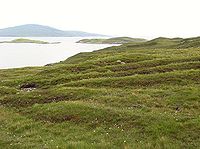
Lazy bed
Encyclopedia


Cord rig
Cord rig is the name given by archaeologists to a system of cultivation practiced in prehistoric and later upland Britain.Spades were used to excavate raised banks for cultivation with channels running alongside for drainage. Where it survives, it consists of parallel ridges of earth around 1 m...
cultivation, parallel banks of ridge and furrow
Ridge and furrow
Ridge and furrow is an archaeological pattern of ridges and troughs created by a system of ploughing used in Europe during the Middle Ages. The earliest examples date to the immediate post-Roman period and the system was used until the 17th century in some areas. Ridge and furrow topography is...
are dug by spade although lazy beds have banks that are bigger, up to 2.5m in width, with narrow drainage channels between them.
Although it is largely extinct, it is still to be found in parts of the Hebrides
Hebrides
The Hebrides comprise a widespread and diverse archipelago off the west coast of Scotland. There are two main groups: the Inner and Outer Hebrides. These islands have a long history of occupation dating back to the Mesolithic and the culture of the residents has been affected by the successive...
where lazybeds are known as feannagan (fjan̪ˠakən) in Scottish Gaelic, and the west of Ireland
Ireland
Ireland is an island to the northwest of continental Europe. It is the third-largest island in Europe and the twentieth-largest island on Earth...
. In these places, the method used is normally to lift up sods of peat
Peat
Peat is an accumulation of partially decayed vegetation matter or histosol. Peat forms in wetland bogs, moors, muskegs, pocosins, mires, and peat swamp forests. Peat is harvested as an important source of fuel in certain parts of the world...
and apply seaweed fertiliser
Seaweed fertiliser
Seaweed fertiliser, also spelt seaweed fertilizer, several of the 12,000+ varieties in the ocean have been shown to be valuable additions to the organic garden and can be abundantly available free for those living near the coast...
(desalinated) to improve the ground. Potatoes were often grown in this way in these regions, until the potato blight Phytophthora infestans
Phytophthora infestans
Phytophthora infestans is an oomycete that causes the serious potato disease known as late blight or potato blight. . Late blight was a major culprit in the 1840s European, the 1845 Irish and 1846 Highland potato famines...
caused the potato famine
Potato famine
Potato famine may refer to:* Great Famine , the famine in Ireland between 1845 and 1852* Highland Potato Famine, a major agrarian crisis in the Scottish Highlands from 1846 to 1857...
in the Highlands and Ireland.
It was used in southern parts of Britain from the post-Roman period until the post-medieval period, and across much of Ireland and Scotland until the 19th century.

